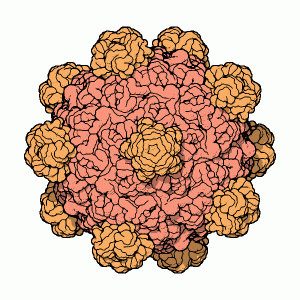|
Inhaltsübersicht | Nanomaschinen | Moleküle | Programme | Kurse | Fun | Links |
||
| > |
Bacteriophage phiX174

A Milestone at the PDB
Animal, Mineral, or Vegetable ?
A bacteriophage is a virus that attacks bacteria. The phiX174 bacteriophage attacks the common human bacteria Escherichia coli, infecting the cell and forcing it to make new viruses. Do you think that viruses are living organisms? PhiX174 is composed of a single circle of DNA surrounded by a shell of proteins. That's all. It can inject its DNA into a bacterial cell, then force the cell to create many new viruses. These viruses then burst out of the cell, and go on to hijack more bacteria. By itself, it is like an inert rock. But given the proper bacterial host, it is a powerful reproducing machine. What do you think? Is it alive?
A Molecular Time Bomb
The capsid of phiX174 is designed to find bacterial cells, and then infect them with its DNA. Sixty copies of the capsid protein (colored red here) form a spherical shell around the DNA, and the spike proteins (colored orange here) form 12 pentagonal spikes on the surface. It is thought that the DNA is ejected through the middle of the spikes when the virus infects an Escherichia coli cell. The DNA itself encodes 11 genes. In order to fit into this tiny protein shell, however, the DNA is so short that the genes must actually overlap.
Next: Assembling a Virus
Last changed by: A.Honegger,